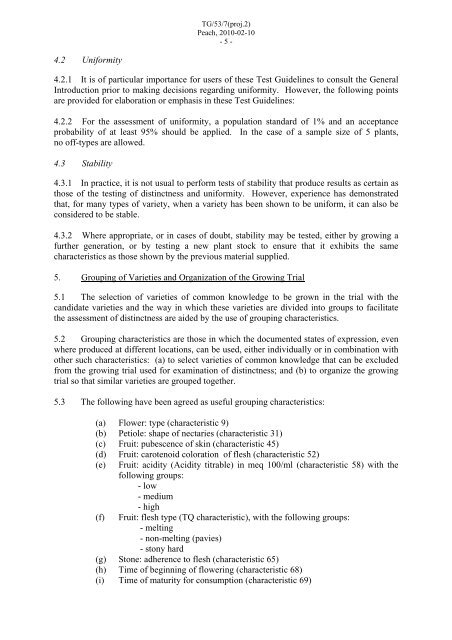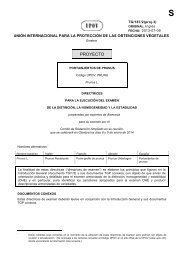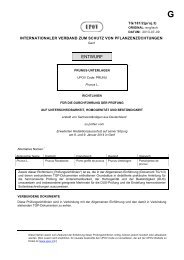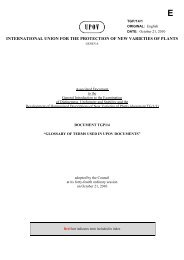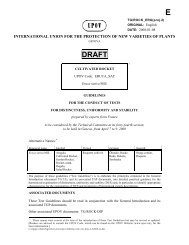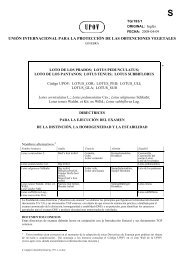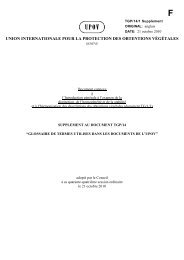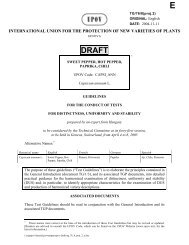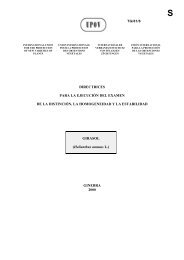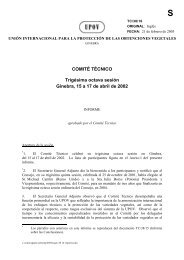E - International Union for the Protection of New Varieties of Plants
E - International Union for the Protection of New Varieties of Plants
E - International Union for the Protection of New Varieties of Plants
You also want an ePaper? Increase the reach of your titles
YUMPU automatically turns print PDFs into web optimized ePapers that Google loves.
4.2 Uni<strong>for</strong>mity<br />
TG/53/7(proj.2)<br />
Peach, 2010-02-10<br />
- 5 -<br />
4.2.1 It is <strong>of</strong> particular importance <strong>for</strong> users <strong>of</strong> <strong>the</strong>se Test Guidelines to consult <strong>the</strong> General<br />
Introduction prior to making decisions regarding uni<strong>for</strong>mity. However, <strong>the</strong> following points<br />
are provided <strong>for</strong> elaboration or emphasis in <strong>the</strong>se Test Guidelines:<br />
4.2.2 For <strong>the</strong> assessment <strong>of</strong> uni<strong>for</strong>mity, a population standard <strong>of</strong> 1% and an acceptance<br />
probability <strong>of</strong> at least 95% should be applied. In <strong>the</strong> case <strong>of</strong> a sample size <strong>of</strong> 5 plants,<br />
no <strong>of</strong>f-types are allowed.<br />
4.3 Stability<br />
4.3.1 In practice, it is not usual to per<strong>for</strong>m tests <strong>of</strong> stability that produce results as certain as<br />
those <strong>of</strong> <strong>the</strong> testing <strong>of</strong> distinctness and uni<strong>for</strong>mity. However, experience has demonstrated<br />
that, <strong>for</strong> many types <strong>of</strong> variety, when a variety has been shown to be uni<strong>for</strong>m, it can also be<br />
considered to be stable.<br />
4.3.2 Where appropriate, or in cases <strong>of</strong> doubt, stability may be tested, ei<strong>the</strong>r by growing a<br />
fur<strong>the</strong>r generation, or by testing a new plant stock to ensure that it exhibits <strong>the</strong> same<br />
characteristics as those shown by <strong>the</strong> previous material supplied.<br />
5. Grouping <strong>of</strong> <strong>Varieties</strong> and Organization <strong>of</strong> <strong>the</strong> Growing Trial<br />
5.1 The selection <strong>of</strong> varieties <strong>of</strong> common knowledge to be grown in <strong>the</strong> trial with <strong>the</strong><br />
candidate varieties and <strong>the</strong> way in which <strong>the</strong>se varieties are divided into groups to facilitate<br />
<strong>the</strong> assessment <strong>of</strong> distinctness are aided by <strong>the</strong> use <strong>of</strong> grouping characteristics.<br />
5.2 Grouping characteristics are those in which <strong>the</strong> documented states <strong>of</strong> expression, even<br />
where produced at different locations, can be used, ei<strong>the</strong>r individually or in combination with<br />
o<strong>the</strong>r such characteristics: (a) to select varieties <strong>of</strong> common knowledge that can be excluded<br />
from <strong>the</strong> growing trial used <strong>for</strong> examination <strong>of</strong> distinctness; and (b) to organize <strong>the</strong> growing<br />
trial so that similar varieties are grouped toge<strong>the</strong>r.<br />
5.3 The following have been agreed as useful grouping characteristics:<br />
(a) Flower: type (characteristic 9)<br />
(b) Petiole: shape <strong>of</strong> nectaries (characteristic 31)<br />
(c) Fruit: pubescence <strong>of</strong> skin (characteristic 45)<br />
(d) Fruit: carotenoid coloration <strong>of</strong> flesh (characteristic 52)<br />
(e) Fruit: acidity (Acidity titrable) in meq 100/ml (characteristic 58) with <strong>the</strong><br />
following groups:<br />
- low<br />
- medium<br />
- high<br />
(f) Fruit: flesh type (TQ characteristic), with <strong>the</strong> following groups:<br />
- melting<br />
- non-melting (pavies)<br />
- stony hard<br />
(g) Stone: adherence to flesh (characteristic 65)<br />
(h) Time <strong>of</strong> beginning <strong>of</strong> flowering (characteristic 68)<br />
(i) Time <strong>of</strong> maturity <strong>for</strong> consumption (characteristic 69)


